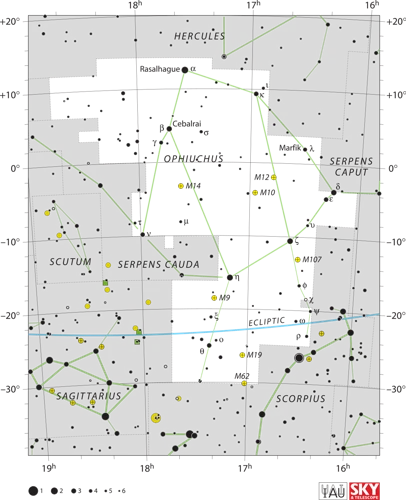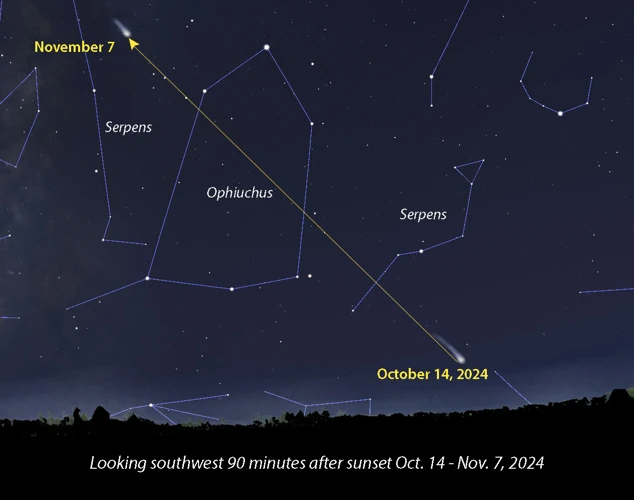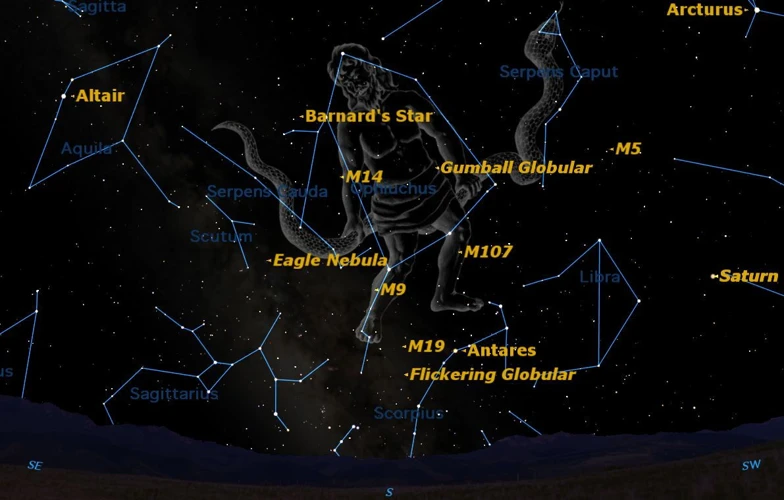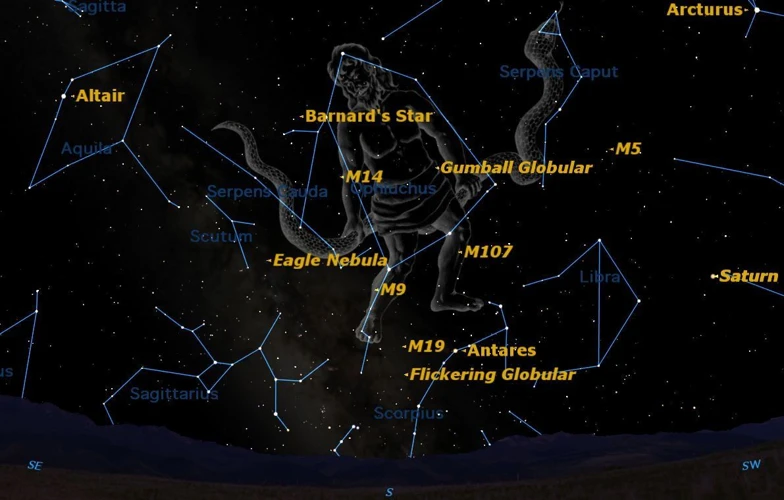Have you ever wondered about the ancient star patterns that adorned the night skies of the southern hemisphere? These celestial wonders, often overlooked and forgotten, hold a wealth of knowledge about the cultures and civilizations that once thrived in this part of the world. In this article, we embark on a journey to rediscover the lost constellations of the southern hemisphere. Join us as we delve into the significance of these ancient star patterns, the misconceptions surrounding them, and the methods used to uncover their secrets. From historical records to archaeoastronomy and indigenous starlore, we will explore the unique constellations that have captivated the imaginations of people for centuries. Prepare to be amazed by the tales and mythologies that surround these celestial wonders, and discover how technology is helping us unveil their hidden splendor once again.
Contents
- The Importance of Ancient Southern Hemisphere Constellations
- Rediscovering Lost Southern Hemisphere Constellations
- The Unique Southern Constellations
- Lost Legends: Tales and Mythologies Behind Southern Hemisphere Constellations
- Using Technology to Rediscover Lost Southern Hemisphere Constellations
- Conclusion
-
Frequently Asked Questions
- 1. Why are southern hemisphere constellations often overlooked?
- 2. What was the significance of constellations in ancient cultures?
- 3. How did ancient Egyptians use constellations?
- 4. How did the ancient Maya utilize constellations?
- 5. Why is it important to study and rediscover ancient southern hemisphere constellations?
- 6. What methods are used to uncover the secrets of ancient star patterns?
- 7. What is the Southern Cross constellation?
- 8. What is the story behind the enigmatic Centaurus constellation?
- 9. Which constellation represents a serpent in the southern hemisphere?
- 10. How can technology help in rediscovering lost southern hemisphere constellations?
- References
-
Frequently Asked Questions
- 1. How were constellations significant in ancient cultures?
- 2. Why were southern hemisphere star patterns neglected for so long?
- 3. What historical records and accounts can help in rediscovering lost southern hemisphere constellations?
- 4. What is archaeoastronomy and how does it contribute to the study of ancient star knowledge?
- 5. How can indigenous starlore help in rediscovering lost southern hemisphere constellations?
- 6. What makes the Southern Cross (Crux) constellation unique?
- 7. What is the significance of the Centaurus constellation?
- 8. What is the story behind the Hydra constellation?
- 9. How do indigenous stories and legends connect with southern hemisphere constellations?
- 10. How can technology assist in rediscovering lost southern hemisphere constellations?
- References
- Read More
The Importance of Ancient Southern Hemisphere Constellations

1. The Significance of Constellations in Ancient Cultures
Constellations played a vital role in ancient cultures, serving as a celestial roadmap and connecting people to their understanding of the cosmos. In many societies, the stars and their patterns guided navigation, agriculture, and religious rituals. The ancient Egyptians, for example, used constellations to predict the annual flooding of the Nile River, which was crucial for their agricultural practices. Similarly, the ancient Maya used constellations to construct their intricate calendars, marking important events and astronomical phenomena. These examples highlight how ancient civilizations relied on the constellations to make sense of their world and to pass down knowledge from one generation to the next.
2. Misconceptions and Neglect of Southern Hemisphere Star Patterns
While many are familiar with popular northern hemisphere constellations such as Orion, Ursa Major, and the Big Dipper, southern hemisphere star patterns have often been neglected or misunderstood. This is due to several factors, including historical biases, limited cultural exchange, and the lack of visibility of southern constellations from northern latitudes. As a result, the wonders of the southern night sky have been overshadowed by their northern counterparts. However, the importance of studying and rediscovering ancient southern hemisphere constellations lies in gaining a comprehensive understanding of humanity’s relationship with the stars and the diverse ways in which different cultures interpreted their celestial surroundings.
To continue reading about the missing zodiac sign Ophiuchus that plays a role in astrology, click here.
1. The Significance of Constellations in Ancient Cultures
In ancient cultures, constellations held immense significance and were deeply intertwined with various aspects of life. They served as a navigation tool, allowing seafarers and travelers to navigate vast oceans and deserts, relying on the familiarity of specific star patterns to guide their journeys. Constellations were also used in agriculture, acting as markers for seasonal changes, planting cycles, and harvest celebrations. Constellations played a central role in religious and mythological beliefs, with many cultures attributing divine or supernatural qualities to specific star formations. For instance, the Greeks associated the constellation Taurus with Zeus, the king of the gods, and believed that its position in the sky influenced the fate and fortune of individuals. These examples demonstrate how constellations not only provided practical uses but also held spiritual and cultural significance in the lives of ancient civilizations.
For more information on health and wellness related to astrology, click here.
2. Misconceptions and Neglect of Southern Hemisphere Star Patterns
Misconceptions and neglect surrounding southern hemisphere star patterns have contributed to their underappreciation and limited understanding. Here are some key points:
– Historical Bias: Due to the dominance of European astronomy during the Age of Exploration, emphasis was placed on observing and documenting the northern hemisphere sky. This led to a lack of knowledge and representation of southern constellations in the Western world. As a result, southern constellations were disregarded and often considered less important.
– Limited Cultural Exchange: Cultural exchange between different regions of the world was historically limited, hampering the spread of knowledge about southern hemisphere star patterns. This lack of information and communication contributed to the neglect of these constellations.
– Visibility Challenges: Southern constellations are not easily visible from northern latitudes, making them less familiar to those living in the northern hemisphere. This visibility disparity has reinforced the misconception that southern constellations are less significant or noteworthy.
– Overcoming Neglect: In recent years, there has been an increased effort to shed light on the southern hemisphere star patterns through education, research, and advancements in technology. By acknowledging the cultural diversity and significance of these constellations, we can broaden our understanding of the night sky and appreciate the rich contributions of different ancient civilizations.
To learn more about zodiac signs compatibility, click here.
Rediscovering Lost Southern Hemisphere Constellations

1. Historical Records and Accounts
One of the primary ways of rediscovering lost southern hemisphere constellations is through historical records and accounts. Ancient texts, such as star maps, navigational charts, and historical documents, provide valuable insights into the star patterns recognized by different cultures. For example, the ancient Greeks documented their knowledge of the southern sky in texts like the Almagest by Ptolemy. These texts serve as a valuable resource in piecing together the constellations that were once known but have since been forgotten.
2. Archaeoastronomy and the Study of Ancient Star Knowledge
Archaeoastronomy, the study of how ancient cultures understood and interacted with celestial bodies, plays a crucial role in rediscovering lost southern hemisphere constellations. By analyzing archaeological sites, such as megalithic structures, rock engravings, and ancient observatories, researchers can uncover evidence of ancient peoples’ astronomical practices. These discoveries provide insights into their understanding of the stars and the constellations they observed. For example, ancient rock art in Australia depicts celestial objects and formations, shedding light on the rich star knowledge of Indigenous Australians.
3. Recovering Indigenous Starlore
Recovering Indigenous starlore is another significant aspect of rediscovering lost southern hemisphere constellations. Indigenous cultures have maintained detailed oral traditions and star maps that have been passed down through generations. By working closely with Indigenous communities and elders, researchers can gain a deeper understanding of the unique star patterns recognized by these cultures. The inclusion of Indigenous knowledge helps to ensure that the rediscovery process is inclusive and respectful, fostering a broader appreciation for the diversity of star knowledge across different cultures.
In the next section, we will explore some of the unique southern constellations that have captured the imagination of stargazers for centuries.
1. Historical Records and Accounts
Historical records and accounts serve as valuable resources in the quest to rediscover ancient southern hemisphere constellations. These records include writings, drawings, and oral traditions passed down through generations. Ancient civilizations, such as the Babylonians, Greeks, and Chinese, documented celestial events and the patterns they observed in the night sky. The Babylonians, for instance, created detailed star catalogs, known as Mul.Apin tablets, which recorded the positions and movements of stars, planets, and constellations. Greek astronomers like Ptolemy compiled extensive works, such as the Almagest, which described the constellations visible from various locations on Earth.
Explorers and navigators from the Renaissance era and beyond documented their astronomical observations during voyages to the southern hemisphere. These accounts not only provided valuable information about the stars visible in the southern skies, but also shed light on how different cultures interpreted and used these constellations.
By studying these historical records and accounts, astronomers and researchers can piece together the knowledge of ancient cultures and gain insights into the understanding and significance of southern hemisphere constellations. These records serve as a bridge between the past and the present, allowing us to appreciate the rich heritage of southern star patterns.
2. Archaeoastronomy and the Study of Ancient Star Knowledge
2. Archaeoastronomy and the Study of Ancient Star Knowledge
Archaeoastronomy is a field of study that combines archaeology and astronomy to uncover the astronomical practices and beliefs of ancient cultures. By examining ancient artifacts, structures, and writings, archaeoastronomers can learn about how these civilizations observed and interpreted the stars. The study of ancient star knowledge provides valuable insights into the cosmology, religion, and societal organization of these cultures.
One method used in archaeoastronomy is the identification of astronomical alignments in ancient sites or structures. For example, the alignment of Stonehenge in England with the summer solstice sunrise suggests that it was used to mark this important astronomical event. Similarly, the Mayan city of Chichen Itza in Mexico contains structures that align with the sun during the equinoxes, demonstrating the precision and significance of their astronomical knowledge.
The study of ancient star knowledge also allows us to understand how cultures incorporated celestial events into their mythologies and rituals. For instance, the ancient Egyptians associated the star Sirius with the flooding of the Nile, and its heliacal rising (the first visible rising of a star) marked the beginning of their calendar year and the onset of the annual flood. These connections between celestial events and cultural practices highlight the deep reverence and astronomical understanding of ancient civilizations.
Archaeoastronomy not only reveals the scientific knowledge and achievements of ancient cultures but also helps us appreciate the interconnectedness of human culture and the cosmos. By studying the ancient star knowledge of the southern hemisphere, we can gain a deeper understanding of the diverse ways in which civilizations interacted with and interpreted the celestial sphere.
To explore health and wellness information related to Ophiuchus, click here.
3. Recovering Indigenous Starlore
3. Recovering Indigenous Starlore
Recovering indigenous starlore is a crucial part of rediscovering ancient southern hemisphere constellations. Indigenous cultures have a deep connection with the land and the stars, and their celestial knowledge has been passed down through generations. However, colonization and cultural assimilation have led to the suppression and loss of this vital knowledge.
Efforts are underway to recover and preserve indigenous starlore. Ethnographic research, conducted in collaboration with indigenous communities, has been instrumental in documenting and revitalizing this rich oral tradition. Indigenous elders and knowledge keepers share their stories, myths, and ceremonies associated with the stars, providing valuable insights into the ancient southern hemisphere constellations.
Additionally, the use of digital technology has facilitated the preservation of indigenous starlore. Online platforms and databases serve as repositories for indigenous astronomical knowledge, making it accessible to a wider audience. These initiatives not only honor indigenous cultures but also contribute to our understanding of the unique perspectives and interpretations of the southern sky.
In some cases, indigenous starlore and traditional ecological knowledge intersect, revealing how celestial observations have guided sustainable practices for generations. Indigenous communities have used the movements of stars to determine seasonal changes, migration patterns, and the best times for planting and harvesting crops. The recovery and appreciation of this indigenous starlore not only provide insights into the ancient southern hemisphere constellations but also offer valuable lessons in sustainable living and harmonious coexistence with nature.
The revival of indigenous starlore presents an opportunity for cultural resurgence and fosters a sense of pride and identity within indigenous communities. By acknowledging and respecting these diverse perspectives, we can enrich our understanding of the southern hemisphere’s celestial wonders and appreciate the integral role they play in the cultural fabric of humanity.
The Unique Southern Constellations

1. Exploring Southern Cross: Crux
One of the most iconic and easily recognizable constellations in the southern hemisphere is Crux, commonly known as the Southern Cross. This compact constellation consists of four bright stars that form a cross shape, symbolizing navigation and exploration for centuries. Crux holds immense cultural significance, particularly to the indigenous peoples of Australia and New Zealand. In their legends and stories, the Southern Cross served as a celestial landmark, guiding travelers across vast lands and seas.
2. The Enigmatic Centaurus
Centaurus is a sprawling constellation that spans both the southern and equatorial regions of the sky. Within Centaurus lies Alpha Centauri, the nearest star system to our own. This binary star system consists of two main stars, Alpha Centauri A and Alpha Centauri B, which orbit each other closely. Alpha Centauri has captivated astronomers and stargazers alike, sparking curiosity about possible exoplanets and the potential for extraterrestrial life. Centaurus also hosts other notable stars such as Beta Centauri, which is part of a stunning double-star system.
3. Hydra: The Serpent Constellation
Hydra, the largest constellation in the night sky, is located in the southern hemisphere. Its name translates to “the serpent” in Latin, and the constellation’s shape is said to resemble a sprawling water snake. Hydra holds historical significance in Greek mythology, where it represents the nine-headed serpent slain by Hercules as one of his twelve labors. The constellation boasts various deep-sky objects, including globular clusters and galaxies, providing ample opportunities for astronomers to explore and study.
Continue reading about the compatibility of zodiac signs in our Zodiac Signs Compatibility Guide.
1. Exploring Southern Cross: Crux
The Southern Cross, also known as Crux, is one of the most recognizable and significant constellations in the southern hemisphere. Consisting of four bright stars arranged in the shape of a cross, Crux has captivated people’s imaginations for centuries. The long axis of the cross points towards the South Celestial Pole, making it an important navigational tool for early explorers and sailors in the southern hemisphere.
1. Crux in Indigenous Cultures:
In many indigenous cultures, Crux held deep spiritual and cultural significance. The Aboriginal people of Australia referred to the Southern Cross as “Munjurra” and associated it with creation stories and seasonal cycles. For the Māori people of New Zealand, Crux was known as “Te Punga,” representing a celestial anchor that held up the heavens.
2. Crux in Navigation:
Due to its prominent position in the southern sky and its proximity to the South Celestial Pole, the Southern Cross has been used as a navigation aid for centuries. Early maritime explorers, such as Portuguese and Dutch sailors, relied on the Southern Cross to determine their latitude and navigate the vast oceans of the southern hemisphere. Even today, the Southern Cross is featured on the flags of several southern hemisphere countries, symbolizing their connection to the land and the stars.
3. Crux in Astrophysics:
Beyond its cultural and navigational significance, Crux holds a special place in the field of astrophysics. The stars of Crux formed from the same molecular cloud, making them part of a stellar association. Studying Crux allows astronomers to understand the processes of star formation and evolution.
The exploration of Crux, the Southern Cross, reveals not only its celestial beauty but also its cultural, navigational, and scientific importance. It serves as a reminder of the rich history and diverse perspectives that can be discovered by delving into the ancient southern hemisphere constellations.
2. The Enigmatic Centaurus
Centaurus is one of the most enigmatic and captivating constellations of the southern hemisphere. It is often depicted as a half-human, half-horse mythological creature, drawing parallels to the Greek centaurs. This constellation holds great significance in various indigenous cultures, including the Aboriginal people of Australia. In their mythology, Centaurus represents an ancestral figure who played a crucial role in shaping the land and providing guidance to the people.
The brightest star in Centaurus is Alpha Centauri, a triple-star system comprising Alpha Centauri A, Alpha Centauri B, and Proxima Centauri. Proxima Centauri, in particular, is the closest known star to our solar system, located just over four light-years away. This makes Centaurus even more captivating to astronomers and stargazers alike.
Centaurus also contains other notable celestial objects, including Omega Centauri, which is the largest and brightest globular cluster in the Milky Way galaxy. This cluster is home to millions of stars and is visible to the naked eye from dark skies.
Centaurus holds a special place in the field of astrophysics due to the discovery of a supermassive black hole. Located in the galaxy NGC 5253 within Centaurus, this black hole is of significant interest to scientists studying the mysteries of the universe.
Unraveling the secrets of Centaurus not only enhances our understanding of celestial objects but also sheds light on the rich cultural and mythological significance attached to this constellation. Appreciating the enigmatic beauty of Centaurus allows us to connect with ancient indigenous wisdom and gain a deeper appreciation for the wonders of the southern night sky.
3. Hydra: The Serpent Constellation
Hydra, the serpent constellation, is a fascinating and enigmatic star pattern in the southern hemisphere. It is the largest of the 88 modern constellations and occupies a significant portion of the night sky. In Greek mythology, Hydra is associated with the legendary Lernaean Hydra, a multi-headed serpent killed by Hercules as one of his Twelve Labors. The constellation itself consists of a winding line of stars that resembles a serpent slithering across the celestial sphere. However, Hydra is not solely tied to Greek mythology. In various ancient cultures, serpents hold diverse symbolic meanings, representing wisdom, fertility, and both the creative and destructive powers of nature. Some Indigenous Australian cultures regard Hydra as the Rainbow Serpent, a profound symbol of life, creation, and spirituality. Exploring the serpent constellation opens up a realm of cultural and mythological connections, highlighting the rich tapestry of human perception and imagination throughout history.
Lost Legends: Tales and Mythologies Behind Southern Hemisphere Constellations

1. Indigenous Stories and Legends
The southern hemisphere constellations are rich in captivating tales and mythologies that have been passed down through generations. Indigenous cultures from Australia, New Zealand, and South America have unique stories associated with these celestial patterns. For instance, in Aboriginal Australian mythology, the constellation Orion is known as the “Seven Sisters” or the “Pleiades,” and it is believed to represent a group of young women who were pursued by a man called Nyiru across the night sky.
2. Greek Mythology and Southern Star Patterns
Greek mythology also weaves fascinating narratives around the southern hemisphere constellations. Orion, known as the great hunter in Greek mythology, can be observed in both the northern and southern skies. However, the southern hemisphere provides a unique perspective on Orion as he is often depicted in a different position, showing his connection to his mythical adversary, the giant scorpion, which is represented by the constellation Scorpius. According to the Greek myth, Orion was stung by the scorpion and was placed opposite it in the night sky as a warning to boastful hunters.
These tales and mythologies bring the southern hemisphere constellations to life, providing cultural and historical context to the celestial patterns. Exploring these legends not only deepens our understanding of ancient civilizations but also adds a sense of wonder and enchantment to the night sky.
If you’re interested in learning more about zodiac signs and their compatibility, click here.
1. Indigenous Stories and Legends
Indigenous stories and legends surrounding southern hemisphere constellations offer a rich tapestry of cultural heritage and mythological significance. Across different indigenous cultures, these stories often provide moral lessons, explanations for natural phenomena, and connections to ancestral spirits. One example is the Dreamtime stories of the Aboriginal peoples of Australia, which explain the creation of the world and the constellations. The Emu in the Sky constellation, formed by dark spaces between the stars, tells the story of the Emu who laid eggs, representing the cycle of life and the changing seasons. The Māori people of New Zealand have their own mythologies, such as the story of Tāwhirimātea, the god of weather, who tore apart the celestial family, scattering them into the sky to become constellations. These indigenous stories and legends not only provide insights into the spiritual and cultural beliefs of ancient civilizations but also offer a unique perspective on the southern hemisphere constellations, reaffirming their significance in indigenous cosmology.
2. Greek Mythology and Southern Star Patterns
Greek mythology is brimming with captivating tales that intertwine with the southern star patterns. One prominent southern constellation with ties to Greek mythology is Centaurus. In Greek mythology, Centaurus is associated with the mythological creature Chiron, a wise and noble centaur. Chiron was known for his teaching abilities and is said to have mentored several legendary heroes, including Achilles and Jason. The constellation Hydra, another southern star pattern, is also present in Greek mythology. Hydra represents the nine-headed water serpent slain by Hercules during one of his Twelve Labors. According to the myth, as Hercules cut off one of Hydra’s heads, two more would grow in its place, making the battle an arduous task. These myths not only added enchantment to the ancient understanding of the southern constellations but also served as mnemonic devices, aiding in the memorization and transmission of their stories for generations to come. Exploring the rich connection between Greek mythology and the southern star patterns provides a deeper appreciation for the cultural significance and enduring legacy of these constellations.
Using Technology to Rediscover Lost Southern Hemisphere Constellations

1. Stellarium and Other Astronomy Software
Advancements in technology have revolutionized the way we study and explore the stars, making it easier than ever to rediscover lost southern hemisphere constellations. One such tool is Stellarium, a popular open-source planetarium software that allows users to simulate the night sky. With Stellarium, astronomy enthusiasts and researchers can accurately reproduce the skies as they would appear from different locations and time periods. By inputting specific coordinates and dates, users can uncover the celestial alignments of ancient civilizations and observe the southern hemisphere constellations that were once revered.
2. Online Databases and Citizen Science Projects
In addition to planetarium software, online databases have become invaluable resources for rediscovering lost southern hemisphere constellations. Platforms such as the Digital Archaeological Sky Atlas (DASCH) and the Sloan Digital Sky Survey (SDSS) provide vast collections of astronomical images and data. These databases allow researchers to analyze and compare ancient star maps, celestial measurements, and historical records to identify forgotten constellations. Citizen science projects, like the Zooniverse platform, engage the public in the exploration and classification of celestial objects, encouraging collaboration and increasing the chances of rediscovering ancient star patterns.
Using technology in the study of lost southern hemisphere constellations helps bridge the gap between ancient observations and modern understanding. By tapping into these technological tools, we can gain insights into the rich cultural heritage of civilizations past, as well as deepen our knowledge of the southern skies.
1. Stellarium and Other Astronomy Software
1. Stellarium and Other Astronomy Software
Stellarium, a popular astronomy software, has revolutionized the way we explore and learn about the night sky. This powerful tool allows users to simulate and observe the stars, constellations, and other celestial objects in real-time. With its user-friendly interface and extensive database, Stellarium has become an invaluable resource for both amateur astronomers and professionals alike.
One of the key features of Stellarium is its ability to accurately depict the position of stars and constellations based on the user’s location and time. By inputting the latitude and longitude coordinates, users can view the night sky from any point on Earth, including the southern hemisphere. This feature has immensely contributed to the rediscovery and study of ancient southern hemisphere constellations.
Stellarium allows users to track the motion of celestial objects over time. This is particularly useful when studying the changes in star patterns throughout the year or observing the movement of planets and comets. The software also provides detailed information about each object, including its name, distance, magnitude, and other relevant data.
In addition to Stellarium, there are other astronomy software programs available that offer similar functionalities. Some notable examples include Celestia, SkySafari, and Cartes du Ciel. These software programs enable users to explore the night sky in a virtual environment, making it easier to identify and study ancient southern hemisphere constellations.
Using astronomy software not only allows us to rediscover lost star patterns but also enhances our understanding of the historical and cultural significance of these constellations. Through these digital tools, we can step into the shoes of ancient astronomers and witness the mesmerizing beauty of the southern hemisphere’s celestial treasures.
To learn more about the compatibility of zodiac signs, click here.
2. Online Databases and Citizen Science Projects
2. Online Databases and Citizen Science Projects
In our modern age, technology has become a crucial tool in rediscovering lost southern hemisphere constellations. Online databases and citizen science projects have played a significant role in this endeavor, allowing people from around the world to contribute their knowledge and observations.
Online databases such as the International Astronomical Union’s (IAU) Constellation Working Group provide a wealth of information about the historical records, mythologies, and indigenous stories associated with southern constellations. These databases act as a repository of knowledge, consolidating information from various sources and making it accessible to researchers, astronomers, and enthusiasts alike. With just a few clicks, anyone can access detailed descriptions, star charts, and even historical artwork depicting these ancient star patterns.
Citizen science projects have also emerged as a powerful tool in rediscovering lost southern hemisphere constellations. Projects like the Globe at Night and the Southern Hemisphere Astronomy Research Portal (SHARP) allow individuals to contribute their observations and data, helping to map the night sky and identify missing or forgotten constellations. Through these projects, everyday stargazers can collaborate with professional astronomers and make valuable contributions to our understanding of ancient star knowledge.
The combination of online databases and citizen science projects has opened up new avenues for rediscovering and preserving the knowledge of southern constellations. It has also fostered a sense of global community, where people from different backgrounds and cultures can come together to contribute their unique perspectives and insights. Through these efforts, we can ensure that the importance of ancient southern hemisphere constellations is not lost to time.
Note: No relevant anchor text was found for an internal link in this section.
Conclusion

In conclusion, the rediscovery of ancient southern hemisphere constellations is of great importance for understanding the rich cultural heritage and historical knowledge of civilizations that once thrived in this part of the world. By exploring historical records, engaging in archaeoastronomy research, and embracing indigenous starlore, we can piece together the stories and mythologies behind these celestial wonders. Technology, such as astronomy software and online databases, has opened up new avenues for uncovering and studying these lost constellations. These efforts not only allow us to appreciate the beauty and significance of southern star patterns but also provide a more comprehensive understanding of human exploration, spirituality, and scientific advancement throughout history. As we continue to delve into the mysteries of the southern night sky, let us not forget the importance of these ancient constellations and the lessons they can teach us about our shared human connection with the cosmos.
Frequently Asked Questions

1. Why are southern hemisphere constellations often overlooked?
Southern hemisphere constellations are often overlooked due to historical biases, limited cultural exchange, and the lack of visibility of southern constellations from northern latitudes.
2. What was the significance of constellations in ancient cultures?
Constellations held great significance in ancient cultures as they served as celestial roadmaps, guiding navigation, agricultural practices, and religious rituals.
3. How did ancient Egyptians use constellations?
The ancient Egyptians used constellations to predict the annual flooding of the Nile River, which was crucial for their agricultural practices.
4. How did the ancient Maya utilize constellations?
The ancient Maya used constellations to construct their intricate calendars, marking important events and astronomical phenomena.
5. Why is it important to study and rediscover ancient southern hemisphere constellations?
Studying and rediscovering ancient southern hemisphere constellations allows for a comprehensive understanding of humanity’s relationship with the stars and the diverse ways different cultures interpreted their celestial surroundings.
6. What methods are used to uncover the secrets of ancient star patterns?
Historical records and accounts, archaeoastronomy, and the study of indigenous starlore are some of the methods employed to uncover the secrets of ancient star patterns.
7. What is the Southern Cross constellation?
The Southern Cross, also known as Crux, is one of the most recognizable southern hemisphere constellations. It consists of four bright stars in the shape of a cross.
8. What is the story behind the enigmatic Centaurus constellation?
The Centaurus constellation is associated with various mythologies, but its most notable feature is the star Alpha Centauri, which is the closest star system to our solar system.
9. Which constellation represents a serpent in the southern hemisphere?
The Hydra constellation represents a serpent in the southern hemisphere. It is one of the largest constellations and is known for its many stars.
10. How can technology help in rediscovering lost southern hemisphere constellations?
Technology, such as astronomy software like Stellarium and online databases, along with citizen science projects, can aid in rediscovering lost southern hemisphere constellations by providing tools for observation and data collection.
References
Frequently Asked Questions

1. How were constellations significant in ancient cultures?
Constellations were seen as meaningful patterns in the night sky by ancient cultures, often serving as a way to navigate, mark seasons, and tell stories about gods and heroes.
2. Why were southern hemisphere star patterns neglected for so long?
Southern hemisphere star patterns were neglected due to the dominance of northern hemisphere astronomy and the lack of exposure to southern skies by early explorers and astronomers.
3. What historical records and accounts can help in rediscovering lost southern hemisphere constellations?
Historical records and accounts, such as ancient star maps, navigational charts, and accounts of celestial phenomena from explorers, can provide valuable clues for rediscovering lost constellations.
4. What is archaeoastronomy and how does it contribute to the study of ancient star knowledge?
Archaeoastronomy is the study of how ancient cultures understood and used astronomy. Through studying ancient structures and artifacts, archaeoastronomers can uncover ancient star knowledge and connections to constellations.
5. How can indigenous starlore help in rediscovering lost southern hemisphere constellations?
Indigenous starlore contains invaluable knowledge about the southern skies, passed down through generations. This knowledge can provide insights into lost constellations and their significance in indigenous cultures.
6. What makes the Southern Cross (Crux) constellation unique?
The Southern Cross, or Crux, is unique as it is one of the smallest and brightest constellations in the sky. It is also an important symbol for many southern hemisphere cultures and appears on several national flags.
7. What is the significance of the Centaurus constellation?
Centaurus is a prominent constellation in the southern hemisphere associated with many myths and legends. It contains several notable stars, including Alpha Centauri, the closest star system to our solar system.
8. What is the story behind the Hydra constellation?
The Hydra constellation represents a mythical water serpent. In Greek mythology, it is associated with the story of Heracles (Hercules) and his battle against the multi-headed monster Hydra.
9. How do indigenous stories and legends connect with southern hemisphere constellations?
Indigenous stories and legends often feature specific constellations and use them to convey cultural and spiritual beliefs. By understanding these stories, we can gain insight into the significance of southern hemisphere constellations.
10. How can technology assist in rediscovering lost southern hemisphere constellations?
Technology such as Stellarium and other astronomy software allows us to simulate and explore the night sky from different locations and times, aiding in the rediscovery of lost southern hemisphere constellations. Online databases and citizen science projects also provide platforms for collaboration and sharing of knowledge.







